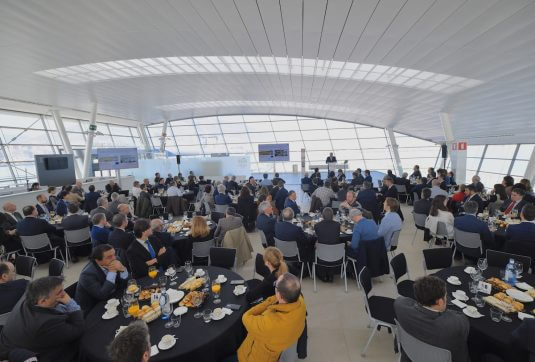- The Port of Bilbao has already achieved the forecasted traffic figures set out for 2020, but still considering the economic forecasts, maintains its objectives until 2022.
- Advances, as planned, in the creation of new land surfaces to accommodate strategic and intermodal projects as well as in environment management and in digitalisation.
- Its economic-financial sustainability enables commitment to progressive reduction in port taxes to be maintained, while at the same time tackling new investments.
- In order to be more competitive, and offer greater flexibility to customers, the Port Authority demands more management autonomy and the transfer of port competences.
The Port Authority of Bilbao has progressed in the 56 lines of action established in its Strategic Plan for 2018-2022, and has achieved nearly all the goals it had set out. Under the motto Zure etorkizunarekin bat / Committed to your future / Comprometidos con tu futuro, the plan centres on five broad core strategic ideas: growth and competitiveness, economic impact, social benefit, management excellence and economic-financial sustainability.
At the presentation of the results of the first year of the Plan’s execution and forecasts for the coming years, Port Authority Chairman, Ricardo Barkala, emphasised that among the objectives that had been achieved, traffic growth and the recovery of market share stood out (not including energy traffic) both in the hinterland (300 kilometre radius) and in the strategic foreland (the European Atlantic. In 2018, the Port of Bilbao handled 35.6 million tonnes with a greater increase than fixed beforehand (+4%), and with records in container and passenger traffic. Thanks to this growth, the Port has reached traffic forecasts for 2020. Nonetheless, given national and international macroeconomic forecast, the Port Authority, is keeping to the objective set out in the Plan: – to reach the figure of 37.5 million tonnes in 2022.
With regard to works, Barkala underlined that the plans for the first stage of the Central Pier are being carried out on schedule and will be completed this very year, thus providing 334,000 new square metres and a one-kilometre berthing line. He also advanced that it will be fitted out in three phases. Land occupancy already surpasses 87% – one of the highest levels in the Spanish State Ports’ system. It is expected to close 2019 with 89% and reduce it to 83% in 2020 when the new surface becomes operational.
Improvement in intermodality has also advanced throughout the Strategic Plan’s first year. Rail-port traffic increased by 12% in the last year and by 65% in the last six, and the foundations have been put in place for its growth to continue. In this sense, Sibport – the company whose main shareholder is the Port Authority – has been awarded the public tender to manage Júndiz; Pancorbo has begun a new phase and will have a regular weekly train and Arasur will become operational in 2020 once fitting out works on the rail siding are completed.
In addition, the Port Authority is working in collaboration with other public institutions on improving accesses, such as the Southern Rail Bypass, the Atlantic Corridor and the Southern Metropolitan Bypass toll road (with incentives for hauliers).

In environmental management, the Port Authority is promoting different initiatives in line with its pioneering character to be a vehicle for energy change and to boost and encourage the introduction of wind energy. In 2018, the first ship-to-ship gas supply in the European Atlantic was carried out; a pioneering project to implement a more efficient and sustainable lighting system on the docks was implemented as was a transparent policy of continuous monitoring of air quality and noise; and new establishments of wind energy were taken on. One of the main challenges scheduled for this year is to become the first European port to obtain life cycle certification.
With regard to strengthening social benefits, advances have been made in the improvement of electronic administration and a Port Center, the Port of Bilbao’s information centre, has been inaugurated in the Bilbao River Maritime Museum.
The strategy to place the customer at the centre of organisation stems from flexibility in the management to obtain new traffic and new logistics-industrial set ups with made-to-measure solutions. Therefore, in order to be more effective, the Port Authority is demanding a governance model with functional and management autonomy, the transfer of the Port, the establishment of differentiated norms according to each port, and a change in the role of Spanish State Ports centred on coordinating the system.
As far as the economic-financial situation is concerned, the Port Authority enjoys a high solvency level, which is better than that set out in the Strategic Plan, and is in a good starting position to face the risks appearing in the environment (possible economic deceleration and free trade restrictions with the United States and the United Kingdom, or possible increases in fiscal pressure)
Due to all of this, the Port Authority is maintaining its commitment to the reduction in taxes programmed for the coming years with a view to offering its customers an attractive and stable horizon. The reduction will be applied gradually to 5.6 million euros (7.5% of invoicing). This began in 2018 with a 10% reduction on cargo tax, and is awaiting approval by the competent authorities of on the new lands valuation.

 Port access
Port access